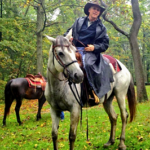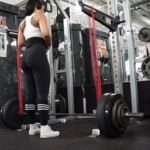
Cherry Hill, instructor, breeder, trainer and judge, has written two new series of books, published by Storey Books, which are designed to be read-and-ride guides. Small enough to fit in the rider’s shirt pocket and spiral bound with laminated front and back covers, these books are meant to be taken to the arena with you. Each of them has diagrams of arena patterns, descriptions of exercises and a short test at the end so that you can guage your progress.
Each of the two series of books, one covering Western Exercises and one covering English exercises, consist of three books – Beginning, Intermediate and Advanced. From the beginning of the first book, Cherry emphasizes the need to take things one step at a time and that the quality of the work is most important.
Each book starts out with a series of goals that the rider should aim to achieve at that level. These goals range from rider balance, steady rhythm, steady gaits and smooth transitions at the Beginning levels, to mastering lateral work, improving collection and learning lead changes at the Advanced levels. In each book there is a section on how to tell if the work you are doing is correct and also what to do if things go wrong. These are the same in both the English and the Western series of books.
Beginning Western Exercises
The first book of the series, Beginning Western Exercises starts out with the halt and a series of questions for you to answer. Among them:-
- Is your breathing deep and regular, or are you holding your breath?
- Are your shoulders back, or are they rounded forward?
- Are your eyes looking straight ahead, or are they looking down?
Cherry notes that in each question, the desirable is mentioned first. The book shows a series of exercises that will help the rider work on corners, transitions and circles. Each exercise is illustrated with a line drawing of the arena layout and the pattern of the exercise shown.
Intermediate Western Exercises
Intermediate Western Exercises is designed to help the rider hone the balance and use of the aids, to improve bending, develop lateral work and begin collection. It does this with a series of exercises beginning with the back, the check, lope-walk-lope transitions and the Western Two-Step, among others. As with the other books, it is illustrated with line drawings, and there is a test at the end.
Advanced Western Exercises
Advanced Western Exercises aims to help the rider fine-tune the transitions, master lateral work and improve collection. The exercises include spirals, the Zigzag Two-Step, the Rollback, small circles at the lope and halt to lope, among others.

The series of books on English exercises follows the same format as the Western series.
Beginning English Exercises
Beginning English Exercises starts out by describing the gaits — the halt, the walk and the working (posting) and sitting trots and the working canter. As in the Beginning Western Exercises book, it describes the footfalls of each gait how the rider should ride the gait and things to avoid. It then moves on to a series of exercises in transitions, changing directions and circles.
Intermediate English Exercises
Intermediate English Exercises has the same goals at the Intermediate Western Exercises book and also many similar exercises — the rein-back, the half-halt, and the leg-yield (the back, the check and the Two-Step) are among the exercises introduced in this book.
Advanced English Exercises
Advanced English Exercises is designed to help the rider fine-tune the transitions and changes of direction, master lateral work and improve collection, using exercises such as counter-flexing, shoulder-in, half pass, collected trot and collected canter.
I enjoyed reading these little books, and if Annapolis wasn’t languishing in his pasture recovering nicely from a bowed tendon at the time of my writing this, I would be tempted to grab the Intermediate English Exercises and head out to the arena with him and try out the exercises. Cherry has done a good job of emphasizing the basics and the importance of balance and rhythm etc. She also points out that they are not meant to be an alternative to regular lessons with a qualified instructor.
My only two demerits against the book have nothing to do with Cherry Hill’s writing. Firstly, I would like to see all the pages laminated. I say this because I can imagine that it would get dirty quite quickly. Sweaty hands on leather reins are not the cleanest in the world and I think the interior pages would quickly get covered in grubby fingerprints.
The other point, which is nothing to do with the content of the book either, is that in all six photographs on the front of the books, only one rider is wearing a safety helmet. I think that any book on riding should try to set an example to riders of all ages and in all disciplines and show riders wearing approved safety headgear.
Those two points aside, these are two excellent series of books, and very reasonably priced making them a good addition to your equestrian bookshelf, whether you ride English or Western.







